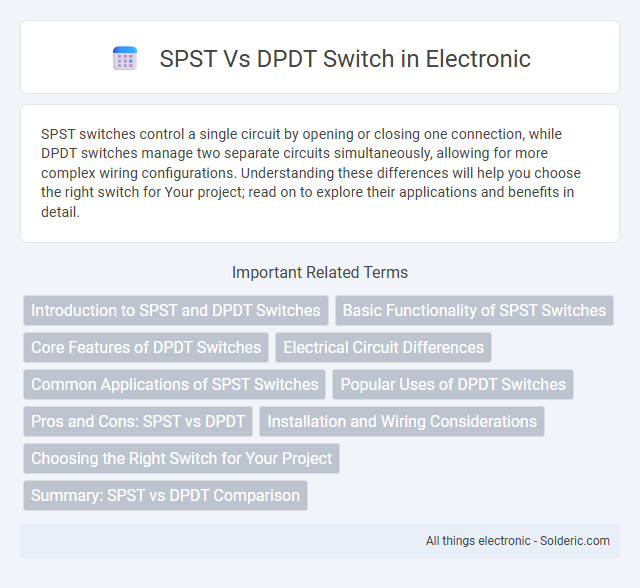SPST switches control a single circuit by opening or closing one connection, while DPDT switches manage two separate circuits simultaneously, allowing for more complex wiring configurations. Understanding these differences will help you choose the right switch for Your project; read on to explore their applications and benefits in detail.
Comparison Table
| Feature | SPST Switch | DPDT Switch |
|---|---|---|
| Full Form | Single Pole Single Throw | Double Pole Double Throw |
| Number of Poles | 1 | 2 |
| Number of Throws | 1 | 2 |
| Function | Controls one circuit with ON/OFF operation | Controls two circuits, can switch between two outputs |
| Common Use | Basic ON/OFF switches | Polarity reversal, selecting between two circuits |
| Contact Configuration | One input to one output | Two inputs, each can connect to one of two outputs |
| Applications | Simple power control, lighting circuits | Motor control, audio switching, complex circuit selection |
| Size and Complexity | Smaller, simpler design | Larger, more complex design |
Introduction to SPST and DPDT Switches
SPST (Single Pole Single Throw) switches control a single circuit by opening or closing a single connection, making them ideal for simple on/off functions. DPDT (Double Pole Double Throw) switches manage two separate circuits simultaneously and can divert current between two different paths, providing more complex control options. Your choice between SPST and DPDT switches depends on whether you need basic switching or more versatile circuit management.
Basic Functionality of SPST Switches
SPST (Single Pole Single Throw) switches control the flow of electricity in a simple on/off manner by connecting or disconnecting a single circuit. These switches are commonly used in applications requiring straightforward control, such as turning lights or devices on and off. Their basic design allows for efficient circuit interruption without complex wiring configurations.
Core Features of DPDT Switches
DPDT switches have six terminals that allow control of two separate circuits simultaneously, making them ideal for complex electrical applications requiring polarity changes or circuit reversal. They enable toggling between two different output paths or switching the direction of current, which SPST switches--operating as simple on/off controllers--cannot accomplish. Your projects benefit from the versatility and increased control options that core DPDT switch features provide in diverse wiring configurations.
Electrical Circuit Differences
SPST (Single Pole Single Throw) switches control one circuit by opening or closing a single electrical path, making them ideal for simple on/off functions. DPDT (Double Pole Double Throw) switches manage two separate circuits simultaneously, allowing you to route current between two circuits or change the direction of current flow in complex wiring setups. Choosing the right switch depends on your circuit requirements, with SPST suitable for basic control and DPDT offering versatile switching options in electrical systems.
Common Applications of SPST Switches
SPST switches are commonly used in simple on/off power control circuits, such as flashlight switches and small appliance toggles, due to their single-pole, single-throw configuration. These switches provide a straightforward method to complete or interrupt a circuit, making them ideal for applications where only one control point is necessary. Your devices benefit from the reliability and ease of use that SPST switches offer in controlling power flow efficiently.
Popular Uses of DPDT Switches
DPDT switches are widely used in electrical applications requiring control of two separate circuits or the ability to reverse motor direction. Common uses include audio signal routing, motor control in robotics, and switching between different power sources. Their versatility in managing complex switching functions makes them essential in industrial automation and electronic projects.
Pros and Cons: SPST vs DPDT
SPST switches offer simplicity, compact size, and cost-effectiveness, making them ideal for basic on/off control in low-complexity circuits, but their functionality is limited to single pole single throw applications. DPDT switches provide versatile control by allowing you to manage two separate circuits simultaneously or reverse polarity, which is essential in motor control and complex wiring scenarios, though they are larger, more expensive, and require more intricate installation. Choosing between SPST and DPDT depends on the specific electrical needs of your project, balancing simplicity and cost against flexibility and functionality.
Installation and Wiring Considerations
SPST switches require simple installation with two terminals, making wiring straightforward for basic on/off control circuits. DPDT switches have six terminals, demanding more complex wiring to enable their dual-pole, double-throw functionality, often used for reversing polarity or switching between two circuits. Proper terminal identification and understanding of circuit requirements are crucial to avoid wiring errors and ensure correct switch operation.
Choosing the Right Switch for Your Project
SPST (Single Pole Single Throw) switches control a single circuit with an on/off function, making them ideal for basic applications where simple control is sufficient. DPDT (Double Pole Double Throw) switches manage two independent circuits simultaneously and can also reverse current direction, providing greater versatility for complex wiring setups. Understanding your project's requirements for circuit control and complexity will help you choose the switch type that balances functionality and simplicity effectively.
Summary: SPST vs DPDT Comparison
SPST (Single Pole Single Throw) switches control a single circuit with an on/off function, making them ideal for simple, straightforward applications. DPDT (Double Pole Double Throw) switches manage two separate circuits simultaneously, allowing more complex control like reversing motor directions or switching between power sources. The choice between SPST and DPDT depends on the complexity and number of circuits you need to control.
SPST vs DPDT switch Infographic

 solderic.com
solderic.com